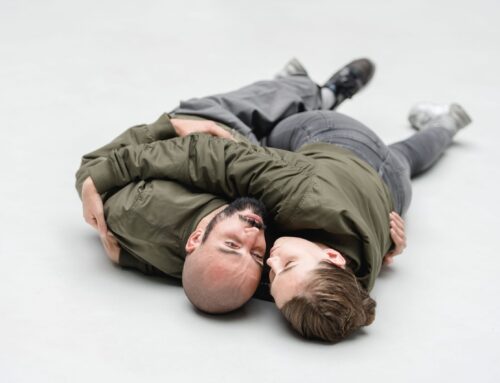Video Impressionen von Louise Lecavalier STATIONS
and our nightreview:
schrit_tmacher justDANCE! Festival starts the 3rd week with Louise Lecavalier
Battery status: 120 percent
On a Monday, many people like to stay at home because the weekend was eventful. But what a shame for them: On stage was Louise Lecavalier, not only an exceptional dancer who, at 64 years of age, must still be described as a force of nature. In the following audience discussion, she also showed the charisma of a 20-year-old, and an extremely modest one.
By Rico Stehfest
translated by Karoline Strys
She has shed the legendary David Bowie fringe and is now wearing her barely tameable blonde curls again. Otherwise, nothing has really changed, nothing at all. And that in the best sense. It’s still (almost) the same black pants, flared at the bottom for the finely chiseled leg work, (almost) the same black jacket that Louise Lecavalier had already worn in her terrific solo „Battleground.“ And her energy is right there, in „Stations“ (2020), still immediately there without any cutbacks and instantly transmits to the audience.
In some sense, this energy is made even visible beyond her complex movement vocabulary, bursting with power and presence: The rectangular dance floor is loosely framed by four columns, not strictly regularly arranged, that glow from within. At first appears a green line that rises up from below – the charging level of a battery. And it is full to the brim. There is no doubt about that for a blink of an eye. Later, at the very end, this charging level does slip into the red area but then it will show that even this is absolutely okay.

Louise-Lecavalier_Stations©TANZweb.org_Klaus-Dilger
And this although at the beginning she still seems to be searching for her position on the big stage. It seems like a testing, a small gesture of a single hand, an uncertain grip on the neck. A quiet rumbling from the speakers which shall increase to an intense pulsation, and off it goes, the unruly and untamed „frontal state“. In her movements, Louise Lecavalier seems introverted and completely present at once. She dances as much for herself as she does for the audience. Given her initial scanning of the space, you might have the impression that she is overwhelmed with the possibilities presented. If she were not Louise Lecavalier.
Calm, contemplative phases stand here on an equal footing with furious, apparently uncoordinated outbursts into wild saxophone sounds, which seem like an incantation ritual. Again and again the mood changes; the piece is leading through four stations. The four shining columns seem mere symbols without setting any dramaturgical caesura. In the end it also becomes clear that it is of no importance whether you can count to four at all this evening. It does not matter where the boundaries between the „stations“ lie or what they want to or could transport in terms of content at all. Dramaturgically, Lecavalier does what she wants anyway. As modest as she may be in her function as choreographer, she knows exactly what she is doing. That is precisely why you shall not underestimate the complexity of individual gestures that repeatedly reach into the very concrete.
There, her fingertips hint at tears running down her cheeks. In the next moment her fingers contort the corners of her mouth into an unnatural grin. Silently clapping her hands, she goes down to the floor, her facial expression and the whole body seem deflated, only she does not stay there for even a second. This artist simply has to move. The short pauses in between are only a tiny absence from movement.

Louise-Lecavalier_Stations©TANZweb.org_Klaus-Dilger
Again and again she returns to a seemingly right-angled geometry, being completely with herself and knowing her personal „battleground“ very well. She knows exactly what is behind everything. This is illustrated towards the end with the song „Nerissimo“ by Teho Teardo and Blixa Bargeld. It says, „I sing what I sing best / Black / The blackest / Until it gets to the other side / And there′s no more / No more darkness left.“ Louise Lecavalier has understood quite a bit. She raises her fists and boxes her way through, literally. Until she finally moves slowly backwards across the stage and it seems as if the darkness swallows her bit by bit.
She emphasized in the following audience discussion that this is indeed a fight for survival. She is completely fragile on stage. And when asked whether there could be a life after dance, Lecavalier gave the only thinkable answer. Even if she were to stop performing, she said, she would still be a body that moves. Thus she will always be dancing.

Louise-Lecavalier_Stations©TANZweb.org_Klaus-Dilger











